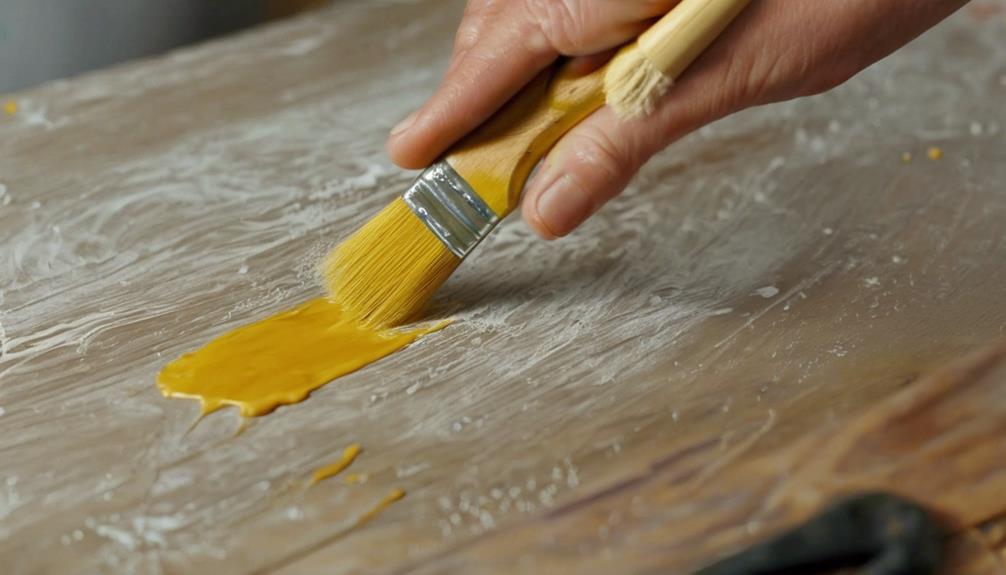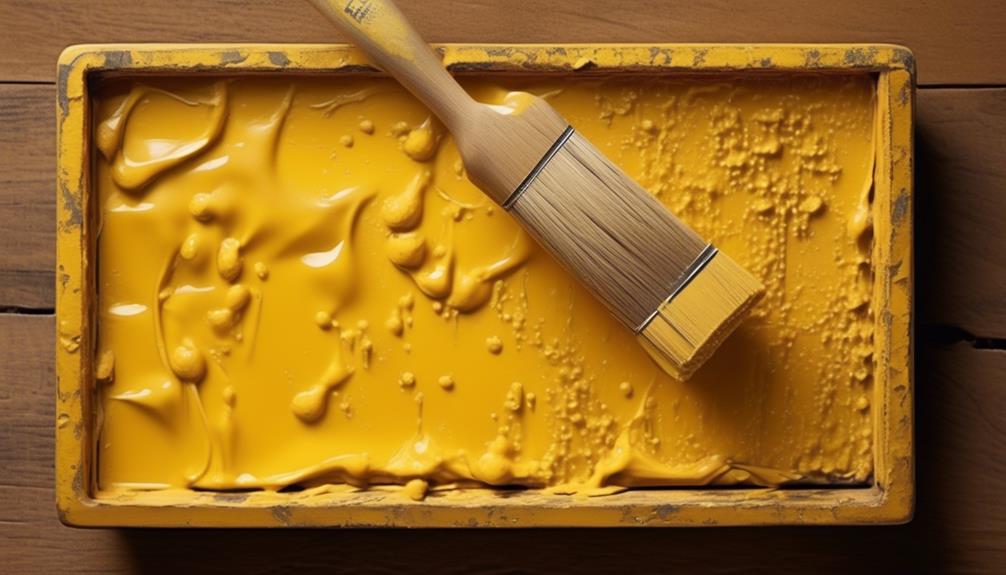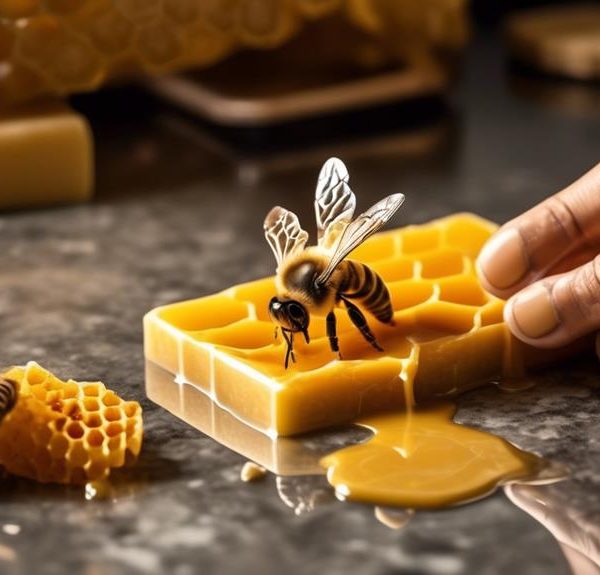Take a deep dive into the world of DIY with our exploration of using beeswax on chalk paint – it's more fascinating than you might think!

Can You Use Bees Wax on Chalk Paint?
Like Da Vinci mixing his own paints in the solitude of his workshop, you too may find yourself considering the properties of various materials in your DIY projects. One question that might be buzzing around in your head is whether you can use beeswax on chalk paint.
Sure, chalk paint has a unique, matte finish that's loved by many, but what happens when you want to give it a little extra protection or a slight sheen? That's where beeswax might come into play.
But before you plunge into your project, let's unpack this a bit further, because there's more to this combination than meets the eye.
Key Takeaways
- Chalk paint is a versatile paint that can adhere to various surfaces without the need for sanding or priming.
- Beeswax is a natural substance that can be applied on chalk paint to enhance its color and provide protection against wear and tear.
- Beeswax creates a smooth, lustrous finish and helps preserve the vibrancy of chalk paint.
- While beeswax is a natural and non-toxic option, it may take longer to dry and requires periodic reapplication.
Understanding Chalk Paint

Before diving into the application of beeswax, it's crucial to understand what chalk paint is and why it's a popular choice for DIY enthusiasts and professional painters alike. Chalk paint is a type of paint that gives a chalky appearance when dried. It's known for its matte, velvety finish and excellent coverage. Unlike most paints, it doesn't require any preparation work like sanding or priming, making it a go-to for time-strapped or novice painters.
What sets chalk paint apart is its ability to adhere to nearly any surface. It's incredibly versatile, perfect for repurposing old furniture, or adding a distressed, vintage look to your pieces. You can use it on wood, metal, glass, and even fabric.
Not only is chalk paint easy to use, but it's also eco-friendly. Most brands are water-based, low-VOC, and non-toxic, making it safer for you and the environment.
Understanding chalk paint and its benefits is key before you start your DIY project. It's more than just a can of paint; it's a tool that can transform your old, worn-out pieces into beautiful works of art.
Now that you're familiar with chalk paint, let's move on to how beeswax comes into play.
Properties of Beeswax

Diving into the world of beeswax, you'll find it's a natural substance with a host of beneficial properties that work wonders on chalk paint. Beeswax is known for its protective qualities, creating a barrier that helps keep the colors of your chalk paint vibrant and resistant to wear and tear.
In its natural state, beeswax is relatively hard but melts easily with heat, making it an ideal ingredient for a variety of products. It's often used in furniture polishes and sealants, as it provides a lustrous finish and increases durability.
Beeswax is also highly resistant to water, helping to preserve your chalk paint from moisture damage. It doesn't stop there, beeswax is non-toxic and safe to use, plus it's a renewable resource, which makes it an environmentally-friendly choice.
The beauty of beeswax lies in its versatility. It can be used alone or combined with other substances to achieve different effects. For instance, mixing beeswax with mineral oil creates a softer, more spreadable wax that's perfect for sealing chalk paint.
Applying Beeswax on Chalk Paint

Now that you're familiar with the properties of beeswax, let's move on to how you can apply it to enhance your chalk paint finishes.
First, ensure your painted surface is clean and dry. Beeswax doesn't stick well to damp or dirty surfaces.
Next, you'll need a clean, lint-free cloth or a wax brush to apply the beeswax. If you're using a cloth, wrap it around your fingers and dip it into the beeswax. If you're using a wax brush, just dip the bristles into the wax.
Now, gently rub the beeswax onto the painted surface. It's crucial to apply it in a thin, even layer, covering the entire piece. A little goes a long way with beeswax, so don't overdo it.
After you've applied the beeswax, let it dry. This could take anywhere from 15 minutes to an hour. Don't rush this part; it's essential for the beeswax to fully set.
Lastly, buff the surface with a clean, dry cloth. This will bring out a beautiful, soft sheen in your chalk paint finish. The result? A durable, vintage-looking piece that's both beautiful and protected.
Pros and Cons of Beeswax Finish

While beeswax can greatly enhance the look and longevity of your chalk paint project, it's important to weigh its advantages and disadvantages before deciding on its use.
On the plus side, beeswax finish gives your chalk paint a richer depth of color and a smooth, lustrous finish. It's a natural product, so you're also avoiding the harsh chemicals found in some other finishes. The application is fairly easy and the finish is durable, providing a layer of protection that helps your painted piece withstand wear and tear.
However, there are a few downsides to consider. Beeswax takes longer to dry than some other finishes, so you'll need to factor in extra time for your project. It's also more expensive than some alternatives, which could be a deterrent if you're on a budget. And while it's generally easy to apply, you might find it difficult to achieve a consistent finish if you're not experienced with using it. It also requires periodic reapplication to maintain its look and protective qualities.
Keep in mind, there's no one-size-fits-all answer. Your choice of finish will depend on your project, your skill level, and your personal preferences.
Helpful Tips for Beeswax Application

Before you start applying beeswax to your chalk painted project, it's essential to gather a few tools and keep some handy tips in mind for a successful application.
First, ensure you're working in a well-ventilated space. Beeswax can be fumy, and you don't want to inhale excessive amounts of it.
Next, gather a clean, lint-free cloth for application, a paintbrush for reaching into crevices, and some fine-grit sandpaper.
Apply the beeswax with your cloth in a circular motion, making sure to cover the entire surface. You should strive for a thin, even layer. Too much wax can result in a gloppy, uneven finish.
If the wax is too hard to spread, soften it slightly with a hairdryer.
After application, let the wax dry for 15-20 minutes before buffing it with another clean cloth. It's important to buff thoroughly for a smooth, even finish.
For areas with intricate details, use your paintbrush to apply the wax. Afterward, use fine-grit sandpaper to smooth any excess wax.
Remember, patience is key here. It may be a slow process, but the end result will be worth it.
Frequently Asked Questions
What Other Types of Wax Can Be Used on Chalk Paint Besides Beeswax?
Sure, there are several other types of wax you can use on chalk paint besides beeswax.
Carnauba wax is a popular choice due to its durability and high-gloss finish.
Another option is paraffin wax, which is easy to work with and gives a nice matte finish.
You can also use specialty furniture waxes designed for chalk paint.
Just remember, each wax has its own unique properties so choose the one that suits your project best.
How Often Should I Reapply Beeswax on Chalk Painted Surfaces?
Absolutely, you can reapply beeswax on chalk painted surfaces.
However, the frequency largely depends on the wear and tear of the item.
On average, it's a good idea to re-wax every 6 to 12 months.
But if it's a heavily used piece like a table or chair, you might need to do it more often.
Can Beeswax Be Applied on Chalk Paint Used on Outdoor Furniture?
Yes, you can apply beeswax on chalk paint used for outdoor furniture. It'll provide a protective layer against the elements.
However, remember it's not as durable as other finishes like polyurethane. You'll need to reapply it more frequently, especially in harsh weather conditions.
Carefully rub in the wax, let it dry, then buff it to a shine. This process will enhance the look of your furniture while offering some protection.
Is Beeswax Safe to Use on Chalk Paint in Children's Rooms?
Yes, you can safely use beeswax on chalk paint in a child's room. It's a natural, non-toxic finish that'll give the painted surface a lovely, durable sheen.
However, remember it's not as hard-wearing as other finishes. So, if the furniture's going to get heavy use, you may want to consider a tougher topcoat.
But for a light-use item, beeswax's soft glow will add a charming touch to any chalk painted piece.
How Does the Finish of Beeswax on Chalk Paint Compare to Other Finishes Like Polyurethane or Varnish?
Yes, you can use beeswax on chalk paint. It gives a soft, mellow finish that's quite different from other finishes like polyurethane or varnish. Those tend to be shinier and harder, while beeswax maintains the matte look of chalk paint.
You'll find it's easier to apply and it's also great for adding a bit of age and character to your piece. But remember, it's not as durable as polyurethane or varnish.
Conclusion
In conclusion, you certainly can use beeswax on chalk paint. It provides a beautiful, durable finish while enhancing the paint's color depth.
However, remember the possible downsides like darkening the color and the need for reapplication over time.
With careful application, beeswax can be a fantastic sealant for your chalk paint projects.
So, go ahead, give it a shot, and see the difference it can make in your chalk painted pieces.



